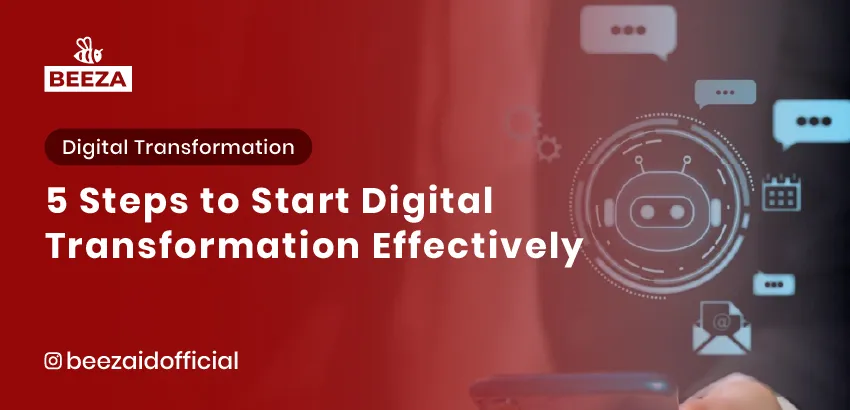
Introduction: 5 Steps to Start Digital Transformation Effectively
Digital transformation is no longer just a trend—it’s a critical step for businesses aiming to survive and thrive in today’s fast-paced, technology-driven world. With changing consumer behavior, rapid tech advancements, and intense market competition, companies are now expected to adopt digital innovations.
Yet, many organizations still struggle to figure out where to begin. This article outlines 5 effective steps to help your business start its digital transformation journey with confidence, efficiency, and long-term impact.
1. Assess Business Needs and Define Digital Goals
Before adopting any technology, businesses must first understand their unique challenges and needs. This includes:
✅ Identifying manual processes that could be automated
✅ Evaluating operational efficiency and bottlenecks
✅ Understanding digital trends relevant to your industry
Example:
A logistics company realized its delivery tracking was still manual, often resulting in errors. After thorough evaluation, the company set a goal to digitize their tracking system and enhance customer experience with real-time updates.
💡 Tip:
Set clear, measurable goals such as:
- Increasing operational efficiency
- Enhancing customer experience
- Improving data-driven decision-making
- Strengthening competitive advantag
2. Choose the Right Technology for Your Business
Technology forms the foundation of digital transformation. Select solutions that align with your business goals and operations, such as:
🔹 Cloud Computing – For scalability and flexibility
🔹 AI & Machine Learning – For automation and smart analytics
🔹 Internet of Things (IoT) – For connecting devices and optimizing workflows
🔹 Big Data & Analytics – For smarter decision-making
🔹 CRM and ERP – For business process integration and customer management
Example:
A small restaurant implemented a cloud-based POS system to manage inventory and orders in real time, reducing waste and improving customer service.
💡 Tip:
You don’t need to adopt all technologies at once. Start with those that will have the greatest short-term impact and scale up over time.
3. Develop a Digital Mindset and Upskill Your Team
Digital transformation isn’t just about tools—it’s about people. It requires a cultural shift and a workforce ready to embrace technology.
📌 Strategies to build a digital mindset:
✅ Provide digital training and certification programs
✅ Encourage a culture of innovation and adaptability
✅ Involve employees in the digital planning process to increase buy-in
Example:
A retail company provided monthly digital training for its staff, enabling them to use tablets to manage inventory, process digital payments, and respond to customer inquiries in real time.
💡 Tip:
Without a digitally capable team, transformation efforts may fail. Ensure your employees understand the benefits of digital tools and feel comfortable using them.
4. Implement Digitally in Phases
Trying to digitize everything at once often leads to failure. A gradual approach allows for better control and reduced risk.
📌 Phased implementation strategy:
🔹 Start with one department or a small pilot project
🔹 Gather feedback from internal users and customers
🔹 Improve and optimize before full-scale deployment
Example:
A cooperative launched an e-KYC system for its micro-loans service first. After positive feedback and improved efficiency, they extended the solution to other financial services.
💡 Tip:
Use an MVP (Minimum Viable Product) approach—test solutions on a small scale, measure performance, and refine before scaling up.
5. Monitor, Evaluate, and Optimize Continuously
Digital transformation is a continuous journey. Post-implementation, companies must actively monitor outcomes and improve strategies based on data.
📌 How to evaluate effectively:
✅ Set and track Key Performance Indicators (KPIs)
✅ Analyze user data and system performance
✅ Stay updated with new technologies and market trends
✅ Be ready to pivot strategies when necessary
Example:
A SaaS startup uses real-time dashboards to analyze which features customers use most. Insights from the data helped them focus on popular features and retire underused ones.
💡 Tip:
Success in digital transformation comes from constant innovation, learning from data, and adjusting strategies to meet evolving demands.
Conclusion
Starting digital transformation can be challenging, but with the right strategy, your business can evolve quickly and efficiently.
Assess your business needs and define clear goals
✅ Choose technologies that align with your objectives
✅ Develop a digital mindset and upskill your team
✅ Implement changes gradually to reduce risk
✅ Monitor, evaluate, and optimize your strategy consistentlyAre you ready to future-proof your business but unsure where to begin? Contact Beeza to discuss tailored digital strategies and solutions that fit your organization. Let’s build a successful digital transformation journey—together.